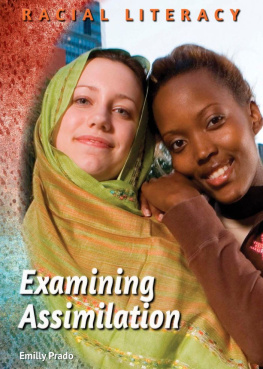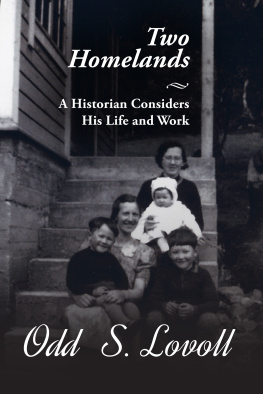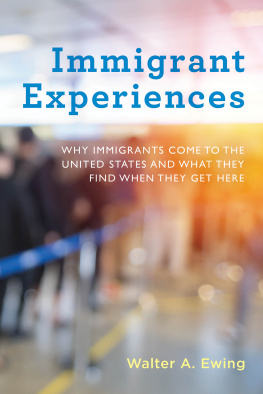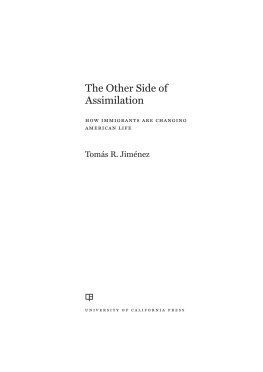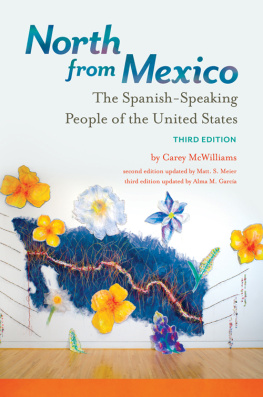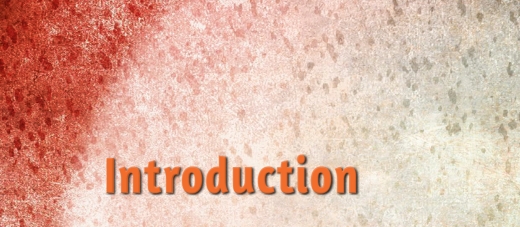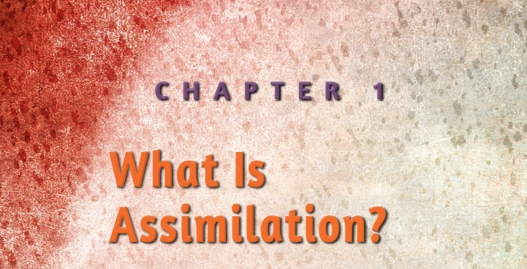Published in 2019 by Enslow Publishing, LLC.
101 W 23rd Street, Suite 240, New York, NY 10011
Copyright 2019 by Enslow Publishing, LLC.
All rights reserved.
No part of this book may be reproduced by any means without the written permission of the publisher.
Library of Congress Cataloging-in-Publication Data
Names: Prado, Emilly, author.
Title: Examining assimilation / Emilly Prado.
Description: New York : Enslow Publishing, 2019. | Series: Racial literacy | Includes bibliographical references and index. | Audience: Grades 7-12. | Identifiers: LCCN 20180152211 ISBN 9781978504691 (library bound) | ISBN 9781978505643 (pbk.) Subjects: LCSH: Immigrants-United States-Juvenile literature. | Immigrants-Cultural assimilation-Juvenile literature. | Americanization-Juvenile literature. | United States-Emigration and immigration-Juvenile literature. | United States-Race relations-Juvenile literature.
Classification: LCC E184.A1 P668 2019 | DDC 305.800973-dc23 LC record available at https://lccn.loc.gov/2018015221
Printed in the United States of America
To Our Readers: We have done our best to make sure all website addresses in this book were active and appropriate when we went to press. However, the author and the publisher have no control over and assume no liability for the material available on those websites or on any websites they may link to. Any comments or suggestions can be sent by email to .
Photo Credits: Cover, p. 1 Golden Pixels LLC/Alamy Stock Photo; p. 6 Rawpixel.com/ Shutterstock.com; p. 7 Interim Archives/Archive Photos/Getty Images; p. 11 GL Archive/Alamy Stock Photo; p. 13 PHAS/Universal Images Group/Getty Images; p. 14 Alex Pena/LatinContent Editorial/Getty Images; p. 17 spatuletail/Shutterstock.com; pp. 20, 39 Bettmann/Getty Images; p. 22 National Geographic Creative/Bridgeman Images; p. 25 Ed Vebell/Archive Photos/Getty Images; p. 27 Hulton Archive/Archive Photos/Getty Images; p. 29 Fotosearch/Archive Photos/Getty Images; p. 32 Prakash Mathema/AFP/Getty Images; p. 34 Dickinson College Archives & Special Collections; p. 36 William Thomas Cain/Getty Images; p. 38 Eliot Elisofon/The LIFE Picture Collection/Getty Images; p. 43 PR Image Factory/Shutterstock.com; p. 46 Richard Levine/Alamy Stock Photo; p. 47 Noam Galai/WireImage/Getty Images; p. 49 Alex Halada/AFP/Getty Images; p. 51 Blend Images/Alamy Stock Photo; p. 52 AP Images; p. 55 iStockphoto.com/SolStock; p. 57 Salim October/Shutterstock.com; p. 59 India Picture/Shutterstock.com; p. 60 Tassii/E+/Getty Images; p. 63 Zurijeta/Shutterstock. com; p. 65 Ken Huang/Stone/Getty Images; p. 66 Danny Feld/The CW Network/ courtesy Everett Collection; p. 68 Monkey Business Images/Shutterstock.com; cover and interior pages background design Ensuper/Shutterstock.com (colors), Miloje/ Shutterstock.com (texture).
CONTENTS
If youre a student in the United States, chances are youve felt the need to fit in at some point in your life. But have you ever thought about what it means to fit in and where the idea comes from? Although there are many different ways people in society try to fit in, a common way people discuss fitting in is by using the idea of assimilation as it relates to culture, immigration, and the American identity. Assimilation is the process of adapting or becoming similar to something.
As the United States has changed and grown older, ideas of assimilation have shifted. Earlier models of assimilation ideas, or theories, such as classic/new assimilation models, date back to the early 1900s. These models focus on the idea that immigrants will become more similar to the dominant culture as time goes on. The 1908 play The Melting Pot by Israel Zangwill popularized the phrasemelting potas itrelates to cultural assimilation and was used widely by politicians and citizens alike.

More than 43.7 million immigrants live in the United States today, making up 13.5 percent of the population.
Like soup or fondue, the melting pot" became a metaphor used to describe the United States as a fused blend of people. Those who believe in the idea of classic assimilation think theres a point when all immigrants can become fully" assimilated and accepted, and they consider complete assimilation a good thing. With the rise of the civil rights movement, however, a new theory of assimilation formed. The racial/ethnic disadvantage model argues that discrimination against people of color prevents full assimilation." This model takes into consideration examples of people who adopt the language of their new country and behave in ways that are in line with American values" but are still treated as less than equal. Segmented assimilation was another popular model in the 1990s that saw assimilation as a process with many factors and a more complicated path than simply fully assimilated or not.
To completely understand assimilation today, we must consider what the end point of assimilation might be and at what cost. By looking at the history of immigrants, refugees, and people of color in US history as well as the countrys shifting borders, we can trace how the ideas that affect identity today have changed over time. Similarly, we can better understand how our own parents, grandparents, and great-grandparents may have been affected by assimilation in the past.

Immigrants arrive at Ellis Island in New York by sea in the early twentieth century.
Even today, cultural assimilation affects our everyday lives. Although the influences of cultural assimilation may not always be obvious, the United States continues to push for one ideal American identity" By better understanding racist laws that have targeted ethnic, religious, racial, and sexual minorities and the stigma marginalized communities face today, we can examine the relationship people have with themselves, their families, and outside of their homes and consider the influences of a centuries-long belief of cultural assimilation.
In the United States and beyond, cultural assimilation is often used as a way to talk about how immigrants and refugees adjust to the culture of their new country. Another way to think about cultural assimilation is that its a way that some people judge how well immigrants fit in with the majority of the population and culture.
While the United States is a diverse country made up of people from many different races and ethnicities, the US Census (a government organization and survey that counts every resident in the country) estimates that, as of 2016, about 61.3 percent of the United States population identifies as white .
One phrase that some people in the United States may have heard from media outlets like television and newspapers, or in classrooms is, The United States is a nation of immigrants. The phrase was made famous by President John F. Kennedy in his 1963 book, A Nation of Immigrants, and celebrates multiculturalism and immigrants . While people use this as a reminder of the United States history and of the Europeans who arrived centuries before, that phrase doesnt tell the full story of the United States or how the country became the diverse nation that it is today. Its important to look at the history of the United States and how it was formed to understand where the idea of assimilation came from, what it means to be an American, and what both ideas mean for people living in the country today.

